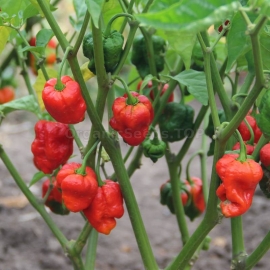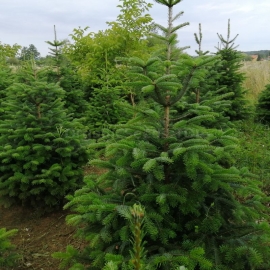







«Carolina Reaper Red» - Organic Hot Pepper Seeds
-
Heirloom Hot Pepper «Carolina Reaper Red»
The Carolina Reaper has held the record of being the world`s hottest chili since November 2013. The variety was cultivated by chili farmer Ed Currie from the PuckerButt Pepper Company in South Carolina (USA).
The name is a reference to the personification of death, the Grim Reaper, and the Carolina Reaper really is fatally hot. Even chili lovers are advised not to eat a whole pepper at once (the breeder also advises only eating them in the presence of another adult). People who are unused to eating hot chilies should not attempt to try it.
The average spice rating tested by the Chile Pepper Institute was 1,569,300 Scoville heat units, while individual specimens reached up to an incredible 2.2 million SHU.
The plant has a bushy growth form and grows up to 90cm tall. The fruits ripen from green to orange and then red, developing a very prominent pointed spike and an uneven surface. They have an aromatic fruity-sweet flavour with notes of chocolate-cherry, a hint of citrus and of course, they are extremely hot. They are almost too hot to be eaten on their own, however they can be dried, pickled, frozen or used to make chili sauces.
The rating on the Scoville scale is 1.500.000 - 2.200.000 SHU.
How to Grow
Chilli peppers are a warm growing plant that has a long time to maturity (usually about 70-100 days). This requires that you start them ahead of time in all but tropical climates where they grow like weeds. Pepper seedlings are quite tough and benefit from transplanting so start in a flat to separate out after sprouting.
Seeds should be soaked in room temperature water for about 30 mins to soften the seed coat. They should be placed, spaced about ½” at least, on pre moistened soil and covered with approximately 1/8” of potting mix. Water in well. Since chilli peppers are a tropical, warm growing plant, bottom heat will both speed up germination and prevent certain cold related rots.
Transplanting
Much like tomatoes, once your chilli pepper plants reach the 3 or 4 leaf stage (the seed leaves plus some true leaves), it is time to transplant them. Take your basic potting mix and add some of your favourite compost and other amendments like blood, kelp or bone meal as directed on the package.
These are quite inexpensive and will really help you have the healthies possible chilli plants. It is also a good idea to add something for a bit of extra drainage as peppers do not like soggy soil. Something like sand or vermiculite. This is best in a 1:3 ratio (sand:soil) for sand and a 1:4 (vermiculite:soil) ratio for vermiculite.
Select a 3 or 4 inch pot and fill it all the way with your pre-moistened potting mix. Separate out your seedlings, always pulling them apart from the roots so you do not break the stems. On a pepper plant, anything below the two initial seed leaves will root. So, like tomato seedlings, bury them “up to the ears”, right up to their lowest set of leaves each in their own pot. If you have lots and want to ensure you get at least one in each pot, you can put two and then thin to the strongest in a week or so. Transplanting like this is important as just the seed root system of a pepper is quite weak.
Continuing Care
Your peppers should be happy in their 3-4” pot until it is time to plant them out, peppers do not get large root systems. Let them dry slightly between watering and provide lots of light. It is a good idea to increase the strength of your fertilizer as the plants grow and you get closer to planting them out as they will use up most of the nutrients in their pots.
The lower leaves may yellow, this is perfectly fine and they can be easily removed with a pair of clean scissors or shears. To strengthen them and prevent mold growing, provide air movement if you grow them in the greenhouse just make sure you open the door and window during the day if it gets too humid inside.

